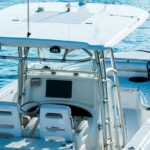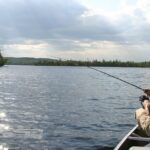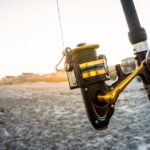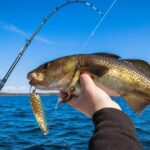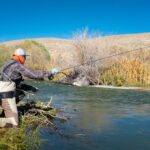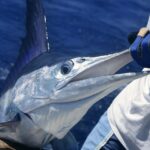One penultimate experience is offshore fishing for game fish, particularly tuna. While pitting their skills against these powerful fish, anglers brave the deeper waters off the USA’s West Coast and further. Anglers need a suitable vessel to reach their quarry, but what is the best boat for tuna fishing?
While there is no one best boat for tuna fishing, tuna boats must be large and strong enough to endure the sudden and drastic changes in sea conditions in the tuna’s offshore environment. There are several superb brands for tuna fishing, including Boston Whaler, Bertram, and Scout.
With all the various tuna class boats available, we must remember that there are particular requirements that a boat must meet for it to be effective for fishing. This article investigates some requirements and examples of ideal boat brands and models for tuna fishing.
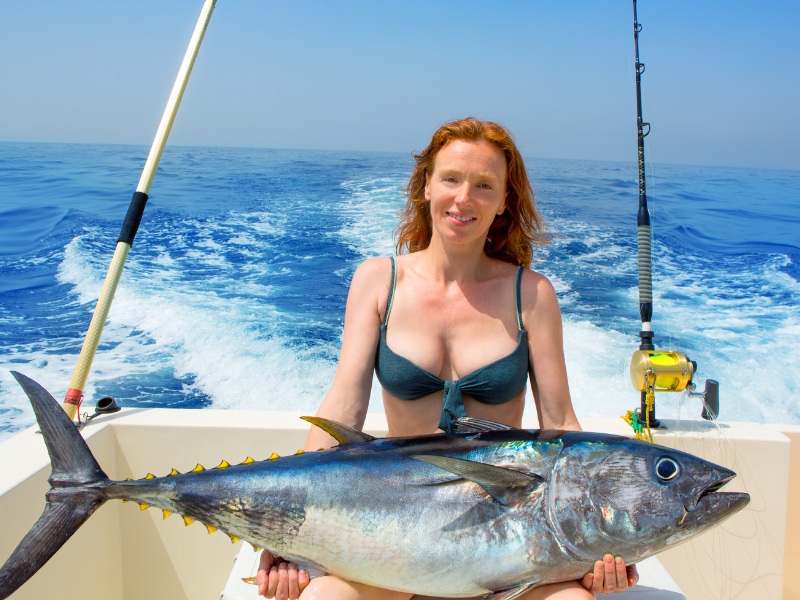
Characteristics Of The Best Boat For Tuna Fishing
Tuna fishing requires a particular type of boat, and although not one brand or model reigns supreme, many of the top brands offer competitive vessels.
While you could head out on any sized skiff to catch tuna (not really), you really shouldn’t! Tuna swim anywhere between 6 and 200 nautical miles from the shore (although most tuna are within 100 nm).
To get to these waters safely, a ship must meet stringent criteria. These criteria include:
Tuna Boats Must Be The Correct Size
While the boat’s total size impacts several factors on the list, the first point is that it needs to be physically big enough to manage the rough waters anglers experience while on the hunt. When you’re far offshore, the waves can get particularly rough, so you’ll need a vessel of at least 30 feet.
The bigger, the better (some recreational fishing vessels are 65 feet), but anything smaller, and you’re taking a huge risk.
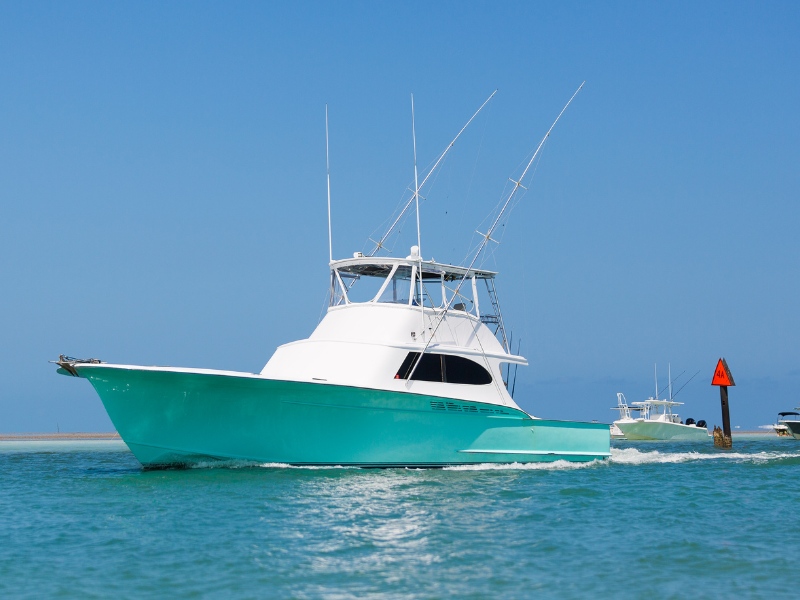
Tuna Boats Require Sufficient Speed
Much like the boat’s size, its speed is essential when offshore. You’ll need a vessel strong enough to fight through waves and quick enough to find the tuna after a long ride out.
Most tuna boats have two motors of at least 175 hp each, which propel the boat along at up to around 30 knots (and more).
Tuna Boats Needs Enough Storage Capacity (Passengers, Gear, And Fish)
Space is essential when out to sea. A long day fishing with traveling out and in cramped conditions is unpleasant and potentially hazardous.
Most offshore vessels can accommodate 7 and more people (up to around 20), but the total number of passengers depends on several factors, including:
- The amount of fishing gear
- The amount of boating equipment (extra fuel, safety equipment, communication devices, etc.)
- The type and amount of fish you plan on catching
- The size and width of your boat, multiplied together, then divided by 15, gives you an estimate of numbers.
It’s essential to ensure your boat is not over-encumbered or risk not having enough power/sitting too low in the water.
Equally important is storage space on board. The last thing you need is for gear to roll around on deck, tripping up passengers or your catch lying around spoiling in the sun.
The best tuna boats have sufficient storage for your gear, safety equipment, and live wells for bait and your catch.
Center Console Boats Are Popular
While not a requirement, many offshore fishing vessels are center consoles.
The benefit of this style is that you have room around the whole boat to fish while simultaneously keeping your instruments and other important electrical equipment in the safest part of the boat.
Dual Console Boats
Similar in design to center console boats, these are usually more comfortable, with a larger area blocked off from the wind.
Open Offshore Boats
While the console is usually exposed, these boats have a raised deck and a cabin. They are also quite large vessels, starting at around 30 feet.
These are some of the most luxurious offshore fishing vessels but also the most expensive.
The Safety Features Must Be Adequate
A tuna boat needs safety equipment and sufficient space for said equipment.
Depending on where you are, the legal safety requirements might vary, but all boats need the following:
- Life jackets
- A throwable device for vessels larger than 16 feet
- An inflatable raft
- Fire extinguisher
- A communication device (VHF-FM Marine Radio with digital selective calling system)
- Emergency Position Indicating Radio Beacon
- Navigation lights and sound-producing devices
- First aid kit
Extras And Comforts For A Tuna Boat
While the comforts and extras are not essential, they often help make the long hours you’ll spend on the boat traveling and fishing more pleasant.
- A freezer to keep drinks cold is a nice touch.
- Cushions on the benches
- Air conditioning
- Cabin – while it’s an extra on a day trip if you’re spending a night on the water, a cabin is essential.
- A fighting chair- these are critical for taking on the biggest, toughest tuna in the sea. Without a fighting chair, you’ll be sorely disadvantaged.
- Enough rod holders – while trolling for tuna, you want the boat to hold the rods for hours it might take to get a bite.
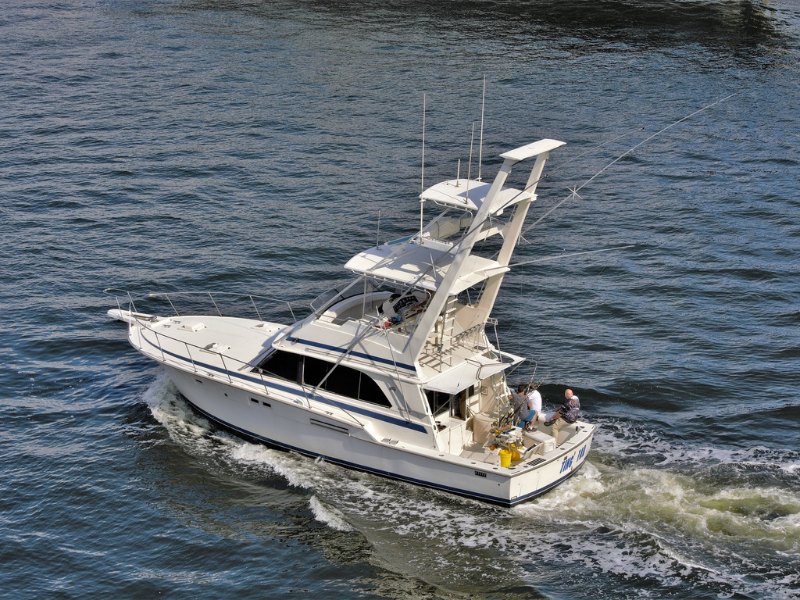
Top Tuna Boats On The Market
While most 30-foot-plus boats equipped with twin 175 hp motors would work for tuna fishing, several are specially designed for tuna fishing and make excellent vessels on the open sea.
The table below examines some of the most popular tuna boats on the market.
| Specification | Albemarle 32 Express | Bertram 35 FlyBridge | Boston Whaler 345 Conquest Pilothouse |
| Length | 32′ | 35’1″ | 35′ 11″ |
| Beam | 13′ | 12’2″ | 11′ 8” |
| Draft | 42″ | 26″ | 22″ |
| Weight | 23 000 lbs (dry) | 20 800 lbs (full load) | 14 200 lbs (dry) |
| Console/cockpit | 76 sq. ft. | 126 sq. ft. | 28″ depth |
| Cabin | yes | yes | yes |
| Carrying capacity | 2x 50 gal fish boxes Optional 20 gal livewell (transom) | Removable port or starboard fish boxes. Transom Livewell | 14 people 5 580 lbs maximum carrying 48 gal Livewell |
| Fuel capacity | 380 gal | 310 gal | 400 gal |
| Top speed | 25 to 35 knots | 36.5 knots | 43 knots |
| Motor type | Twin inboard diesel 480/500hp | Twin 507 mHP CAT | 750 to 1200 hp |
Other fantastic tuna vessels include:
- Boston Whaler 270 Dauntless
- Grady White Freedom 275 Dual Console
- Hatteras GT45X Open
- Luhrs 340 Convertible Sportfish
- Sailfish 320 Express
- Scout 380 LXF
- Scout 420 LXF
- Sea Hunt Gamefish 30
Many charter operators prefer to custom-build their tuna boats to ensure they get what they need and want, which is a fantastic option if you have the funds.
There are many great 30′ class tuna boats on the market. However, there are also some less-than-desirable boats. When choosing a tuna boat, try to keep the following in mind:
- Quality built, with proper construction techniques and materials. The most critical point is your boat should be well-made. When you’re out at sea, the last thing you need is for the inboard to fall out.
- The area you’ll be fishing in. The type of weather and waves you might expect to encounter influences what size and strength boat you’ll need.
- The number of people coming with you (most of the time). Ensuring you have sufficient storage space and carrying capacity is necessary.
- Your local port (access might be an issue if you want a larger vessel) and if you can launch there.
- Your budget. Unfortunately, budget is a limiting factor for most of us, and the other criteria must be viewed through the budget lens. Aside from buying the boat, there are the maintenance, registration, and repair costs.
Conclusion
While there is no perfect boat for tuna fishing, several suitable models are available. Tuna boats must be a minimum of 30′, be powerful enough to get out to the fishing spot, sturdy enough to handle offshore ocean conditions, and comfortable enough for anglers to spend the day on the water.
- Do You Need An Indicator For Nymph Fishing? - November 16, 2023
- Fishing Safety Tips For Families - September 25, 2023
- What Is The Best Time To Night Fish At A Lake? - September 18, 2023


